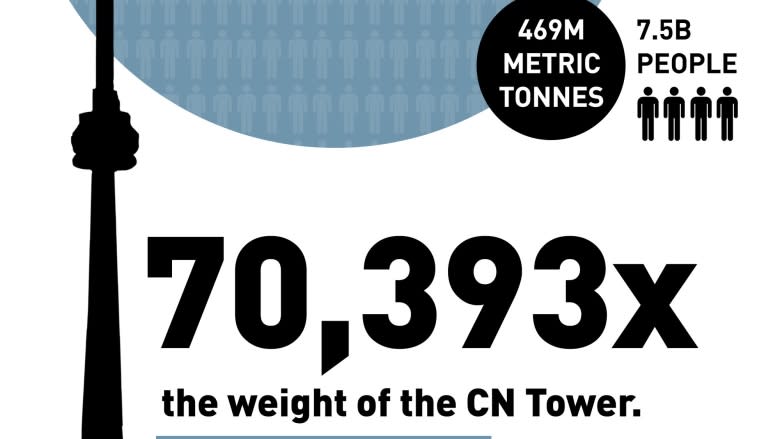Humans have produced 8.3 billion tonnes of plastic, researchers say
Plastic is in almost everything we use. Now researchers have calculated the staggering amount of the synthetic material humans have produced since large-scale production began in the 1950s: 8.3 billion tonnes.
More disturbing, the researchers say, is the amount of plastic waste that humans have produced. Of the 8.3 billion tonnes we've made since 1950, 6.3 billion of that has already become waste.
"We expected the numbers to be large, but somehow we were surprised at how large they are," Roland Geyer, lead author of the study and associate professor in environmental science and management at the University of California, Santa Barbara, told CBC News.
"Even for people like me who do these kinds of material flow analyses for a living, these are enormous quantities."
The number that shocks him the most, however, is the rapid increase in production.
"Of the 8.3 billion metric tonnes of virgin plastics ever made, half was made just in the last 13 years," Geyer said. "Between 2004 and 2015 we made as much plastic as we made between 1950 and 2004."
Choking our ecosystems
The same team responsible for this study was behind a 2015 study that found somewhere between 4.8 million and 12.7 million tonnes of plastic from people living within 50 kilometres of coastlines had made its way into our oceans.
"Our estimate of eight million metric tonnes going into the oceans in 2010 is equivalent to five grocery bags filled with plastic for every foot of coastline in the world," said Jenna Jambeck, co-author of both studies, in a statement at the time. "This annual input increases each year, so our estimate for 2015 is about 9.1 million metric tons," she said.
"In 2025, the annual input would be about twice the 2010 input, or 10 bags full of plastic per foot of coastline," she said. "So the cumulative input by 2025 would equal 155 million metric tonnes."
A recent study found evidence that plastic was making its way into the Arctic Ocean.
"Most humans live in temperate regions and towards equatorial regions, and yet our pollution is not staying in those kind of geographical bounds — they're moving beyond into these remote regions," Jennifer Provencher, a post-doctoral researcher at Acadia University in Wolfville, N.S., told CBC News in May.
There have been several studies on how the plastic is harming wildlife, with a focus on sea birds.
"I'm very concerned," Geyer said of plastic in the ocean. "But in a way I'm equally concerned with plastics in terrestrial ecosystems. We don't even really study the effects of plastics in terrestrial ecosystems. I'm worried that there could be all kinds of unintended adverse environmental consequences."
Plethora of packaging
"We have to be really mindful of plastics," Geyer said. "I'm having the exact same struggle and challenges everyone else has. You come home from the supermarket and you're just amazed at how much packaging there is together with the produce and the food."
While we may be more aware of plastic packaging, the use of plastic fibres in clothing like nylons and fleece has also grown. Between 1950 and 2015, it accounted for one billion tonnes of plastic.
The key, Geyer said, is to ask yourself if you need to buy a product with so much plastic. He notes that some companies like clothing company Patagonia are trying to reduce the amount of plastic in their products. Being mindful in your purchasing habits is key.
"It's something as a society we collectively have to have a good think about," Geyer said. "There's a way to reduce and still have the same services and quality of life. And that would definitely be a simple way to address plastic waste generation; if we just make less in the first place."



